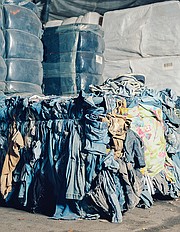The making of Circulose starts by taking cellulose-rich textiles (above), chomping them up in a shredder, refining them further and using a crusher to make pulp, which looks like big sheets of paper (below). Renewcell then sells the Circulose to fiber producers.
PULP FRICTION
Pulp Friction: To craft a more circular supply chain, Renewcell grinds old apparel into new
What is the future of fashion? No, not the next style but the actual process of making and selling it. Increasingly it’s looking like a new paradigm based less on the fast and disposable and more on the durable and recyclable.
Renewcell is a Sweden-based pioneer in turning old garments into new by breaking down apparel and textiles past their prime and turning them into pulp, or sheets of cardboard-like material branded Circulose that can be turned into fiber that could very well wind up in your next pair of jeans. It has already collaborated with companies as large as Levi’s and H&M.
On Nov. 10, Renewcell opened its first full-scale production plant capable of producing 60,000 tons of 100 percent recycled clothing per year. The California Apparel News caught up with Chief Commercial Officer Tricia Carey to find out more about what this new technology holds for closing the loop in the clothes-making process.
CAN: What came first at Renewcell, the company or the technology?
TC: The origins are actually on the academic side. In Sweden there’s a strong culture around pulp production, and we’ve actually been around for 10 years. But we’ve really picked up in the past three years and went public in November 2020 in the middle of the pandemic.
CAN: You recently joined Renewcell. What did you do before?
TC: My background is in wood-based cellulosic fibers. I was at Lenzing for 24 years, where I covered the Americas and the denim market and was part of the growth of Tencel as a branded fiber.
CAN: Explain the new manufacturing plant and what it does.
TC: With this technology you start in a lab, move to pilot and then on to bulk production. We start by taking cellulose-rich textiles, chomp them up in a shredder, refine them further and use a crusher to make pulp, which looks like big sheets of paper, which we then sell to fiber producers.
CAN: What is your mission, especially as it pertains to the future of apparel manufacturing?
TC: The vision is simple: to make fashion circular. Already in the U.S. we have laws in Massachusetts, for example, that say you cannot throw textiles away; they need to be recycled. The hierarchy of waste falls into keeping it in circulation as long as possible through rental, resale and repair. Then, as you move down the hierarchy, you have to address when the garment can no longer be worn but you still have usable fibers. Those textiles are really an asset that people are throwing away, but it doesn’t have to be that way.
So, it’s about technology, investment and building a whole network around circularity where we’re able to shift the linear supply chain into a circular one. But you can’t just twist the linear model into a circle; you have to have new players that are involved: collectors, sorters, preprocessors, and we would be the processor to get those textiles back into the supply chain. What’s really exciting about this technology is that it’s like making history every day. There’s always a new first, and it’s exciting to be a part of this revolution in the apparel space.
CAN: What should players in the apparel industry take from your growth and innovation?
TC: If you’re a brand, you have to start designing into circularity. The multi-component fabric—synthetic and cellulosic in one garment—makes it very difficult for circularity. But even before that it’s designing durable, wearable garments that are going to last for a long time. Brands need to research new materials, and we need to get it from pulp to fiber and yarn, and I can see the Los Angeles market really picking up on that because you have a lot of knitters there.
It’s also about setting goals around circularity and starting to measure what your impact is. You can’t just jump to the table; you need to have direction and purpose. And if you’re looking at recycled materials you need to ask what is the content. There’s a lot of greenwashing that goes on in the market, so you need to know if material is 100 percent recycled and if it’s certified and how to connect all the dots within your supply network. And I say network because you can’t think of it as a chain anymore. We’re shifting away from that old way of thinking of just the company before us and the one after. Now what matters so much more is a network where you’re all connected together.
CAN: What is the range of garments that can be made from Circulose?
TC: Once you have the yarn, you can get the same strength you’d get from a virgin fiber, so it’s very much a plug and play. Circulose can be used in anything from knits and wovens to denim and home applications. It really runs the gamut.























